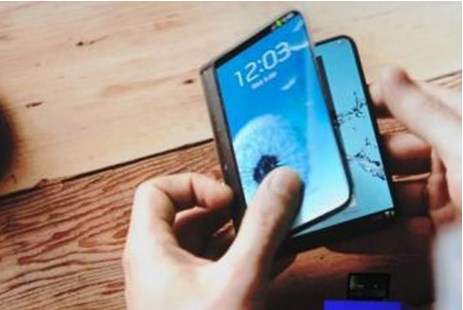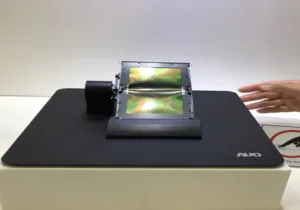The display and smartphone industries are buzzing with expectations about foldable smartphone displays that can spur replacement demand and bring stronger growth to a mature market. Smartphone demand growth-rates have been slowing down in recent years as the market is maturing.

New innovative designs and form factors are expected to help boost replacement demand, especially in mature markets. Can the reality of foldable flexible displays meet the high expectations of the industry and be the panacea for the next generation of smartphones? Or will the reality of manufacturing challenges, supply constraints, high costs and high prices cause demand to lag industry expectations?
Foldable smartphones in the near future
Samsung is expected to introduce its first foldable smartphones in the market in the near future. There is talk in the industry about Samsung’s “Galaxy X” foldable phones prototypes, which are expected to arrive in 2017 in limited numbers to test product designs, consumer interest and the durability of foldable design.
However, many display industry people believe foldable phones can only be ready for volume production in 2019, as technology needs more time to mature. New foldable phones are expected to have two OLED display panels with a hinge in the middle but that can be unfolded for a seamless view. For example, a display can be 5″ diagonal when used as cellphone that can be rolled out to an 8-inch tablet.
Samsung privately showed a foldable phone concept at the 2013 CES, yet it is still not commercialized. The technology needs more development time. Besides Samsung, many other companies are working on foldable phone prototypes. Patent applications from companies such as Apple and others gives some clues about what to expect in future. Some of the patent designs have showed clamshell-type phones. Foldable products can be unidirectional, bi-directional; and can have single fold or multiple folds providing design flexibility.
 Foldable OLED Concept 2013
Foldable OLED Concept 2013
Thin, light unbreakable larger displays in a smaller form factor
Foldable display is considered to be the second generation product for flexible display technology. The third generation is considered to be rollable one and the fourth gen products will be stretchable.
Current flexible display products are passively flexible (or conformable i.e. flexed just once during manufacture, then fixed, like the Samsung Edge phones – Man. Ed.) whereas the next generation products will be actively flexible or foldable. While the display curvature radius of current generation flexible displays may be 8mm, foldable display curvature will be 1-3mm and providing the ability to bend multiple times without degradation.
Stretchable display curvature radius can be less than 1mm. The true potential of foldable display is that it can offer thin, light, unbreakable larger displays for smartphone in a smaller form factor. For display and smartphone suppliers it is expected to offer increase in demand growth-rates, higher ASP and higher profitability. Some customers may be looking for a combination of smartphone and tablet in a smaller form factor than current phablets. That is why top smartphone suppliers like Samsung, Apple, Chinese brands and many others are focusing on foldable displays for smartphones.
Challenges need to be resolved
There are many challenges for foldable display that need to be overcome before reality can match expectations. At the SID 2017 Display week, Dr. Huang (VP at Visionox) talked about the challenges. Foldable displays based on AMOLED with plastic substrates are believed to have great potential to generate novel products. However for small bending radius, foldable display modules face challenges in both materials and process technologies.
Jun Souk, professor at Hanyang University said at the 2016 Displayweek, that all layers of foldable display (panel, touch sensors, polarizer and cover plate) need to be foldable, durable and transparent. It will need flexible OLEDs, with touch sensors such as AgNW or Metal Mesh, flexible adhesive, bendable thin polarizer and flexible window covers. All the layers need to be durable and to be able to withstand multiple bending.
OLED is in the forefront for foldable
OLED display technology is in the forefront for foldable display. Combined with printable OLED manufacturing capabilities- it has the potential to enable lower-cost flexible, foldable, and stretchable display in future. Flexible OLED is expected to gain market share in the smartphone market due to its innovative design differentiation.
Many suppliers were showing foldable smartphone panels at DisplayWeek 2017. Samsung Display has been in the forefront of mobile flexible and foldable OLED. Currently many other suppliers are entering the market especially from China. BOE, Tianma, and many others were showcasing flexible as well as foldable OLED for smartphone at the conference.
JDI was showing a 5.5″ FHD flexible OLED with 401 PPI with SBS-OLED. Tianma showed a 5.5″ flexible AMOLED display with ultra narrow borders, and ultra thin thickness that folded inwards at R3mm. AUO showed a foldable 5-inch 1280x 720 OLED display with plastic substrate that can be bent more than 1 million times. Still it needs two more years for mass production which is expected in 2019.
AUO Foldable OLED at Displayweek 2017
LTPS LCD coming with new design for smartphones
In general, LCD is lagging behind OLED in terms of flexible and foldable display. But at Displayweek 2017, JDI showcased a new design concepts using two thin LTPS LCD with very slim borders that can be incorporated into a foldable design for smartphones. The company showcased a full active 5.5″ FHD LCD with 401 PPI, with four edge free designs, which was realized by pursuing a high-density layout, process and bonding technology. It is expected to bring new value through product design and users interface freedom.
Foldable Display technology need more time to mature
Even though the potential future of next generation foldable displays is very promising, there are many challenges including process technology, materials, manufacturing issues, high capex, higher costs, high price for consumer device, durability of the products, design acceptance by consumers, and consumer willingness to pay higher prices for the new designs. Therefore, foldable display technology needs more time to develop for reality to meet expectations, before it can be a panacea for the next gen smartphone market.
Sweta Dash is the founding president of Dash-Insights, a market research and consulting company specializing in next generations display market research. For more information, contact [email protected] or visit www.dash-insight.com

